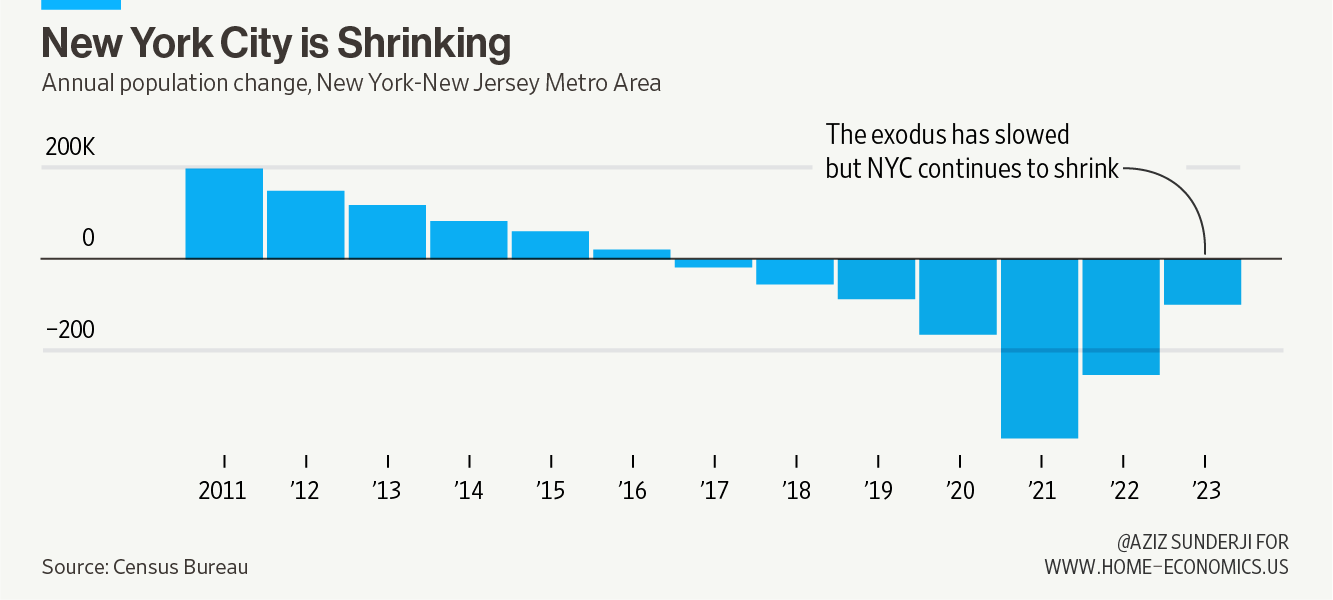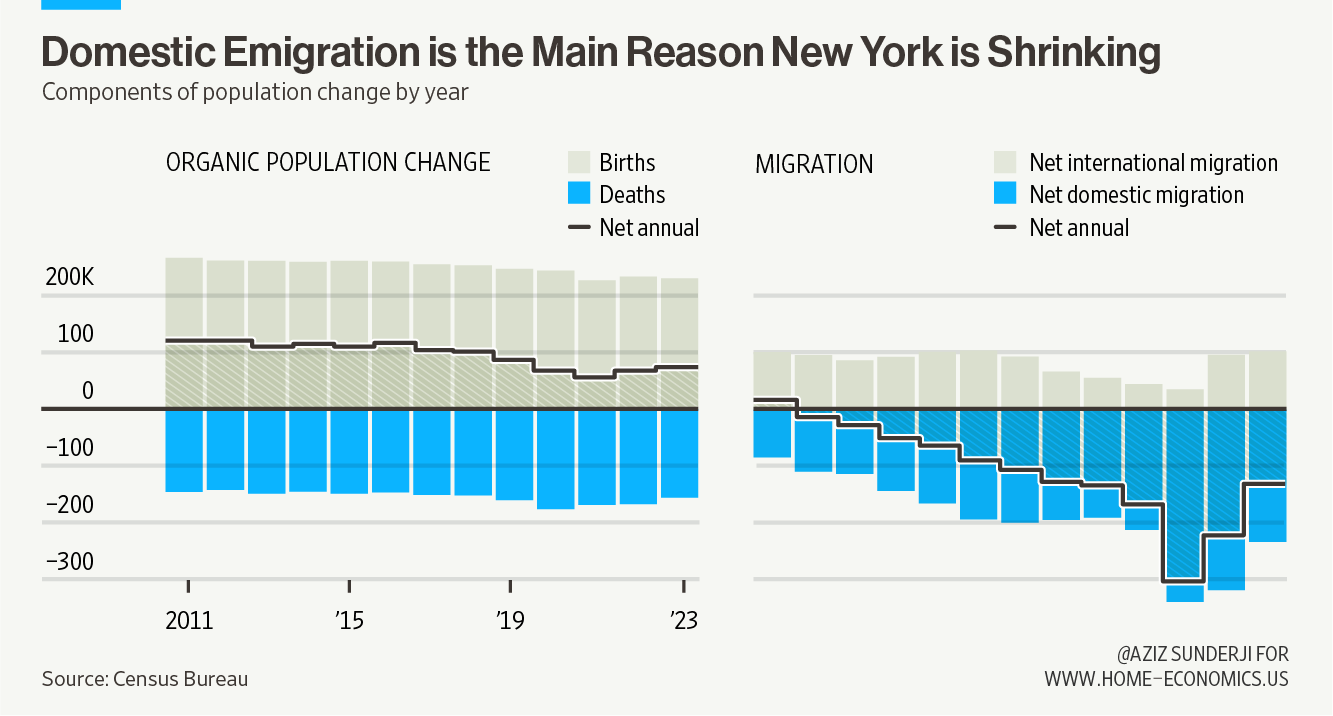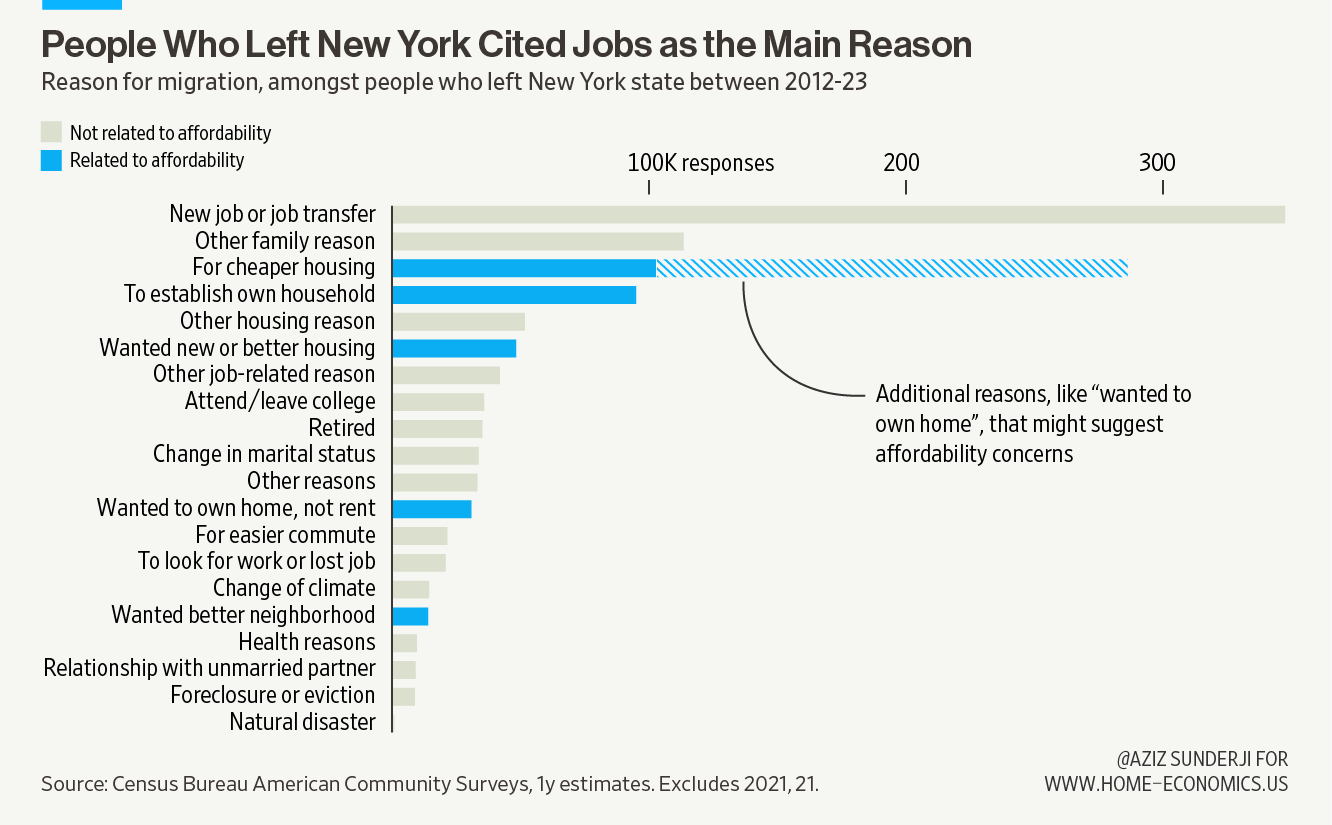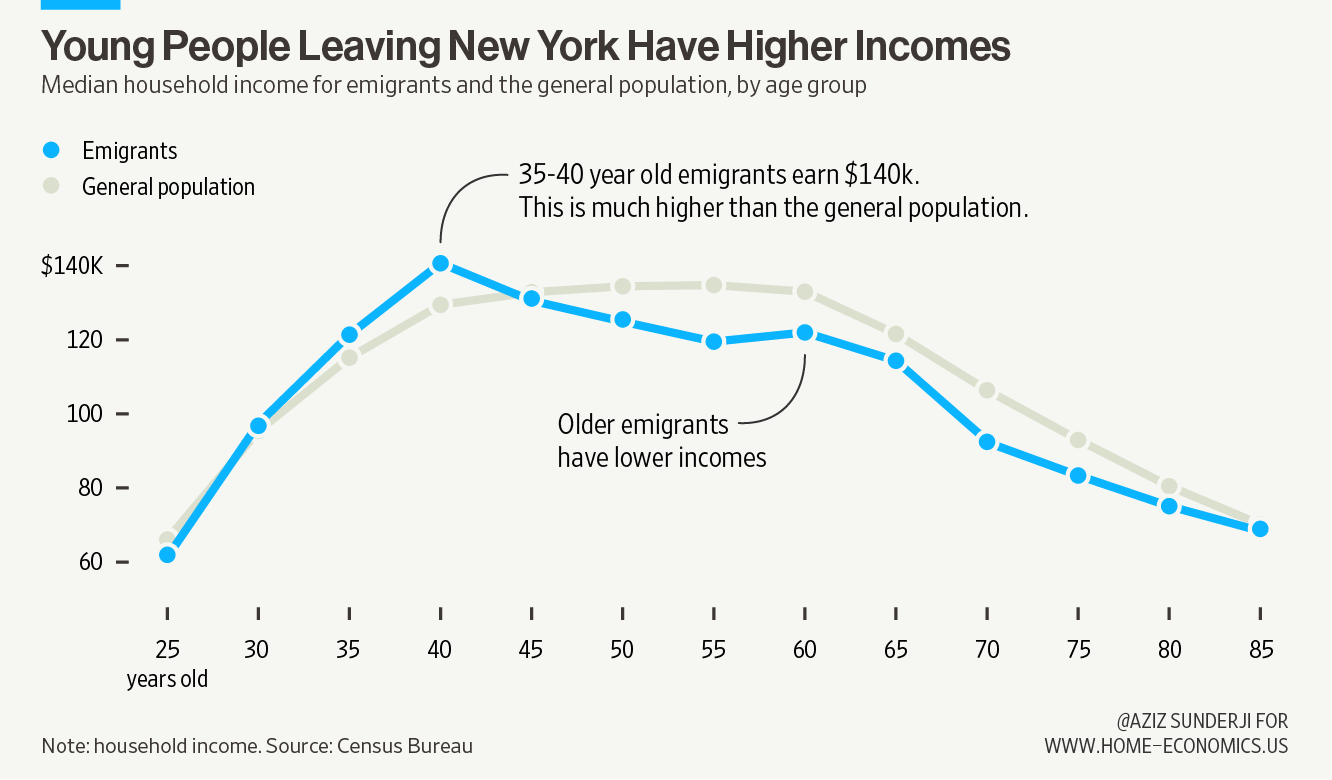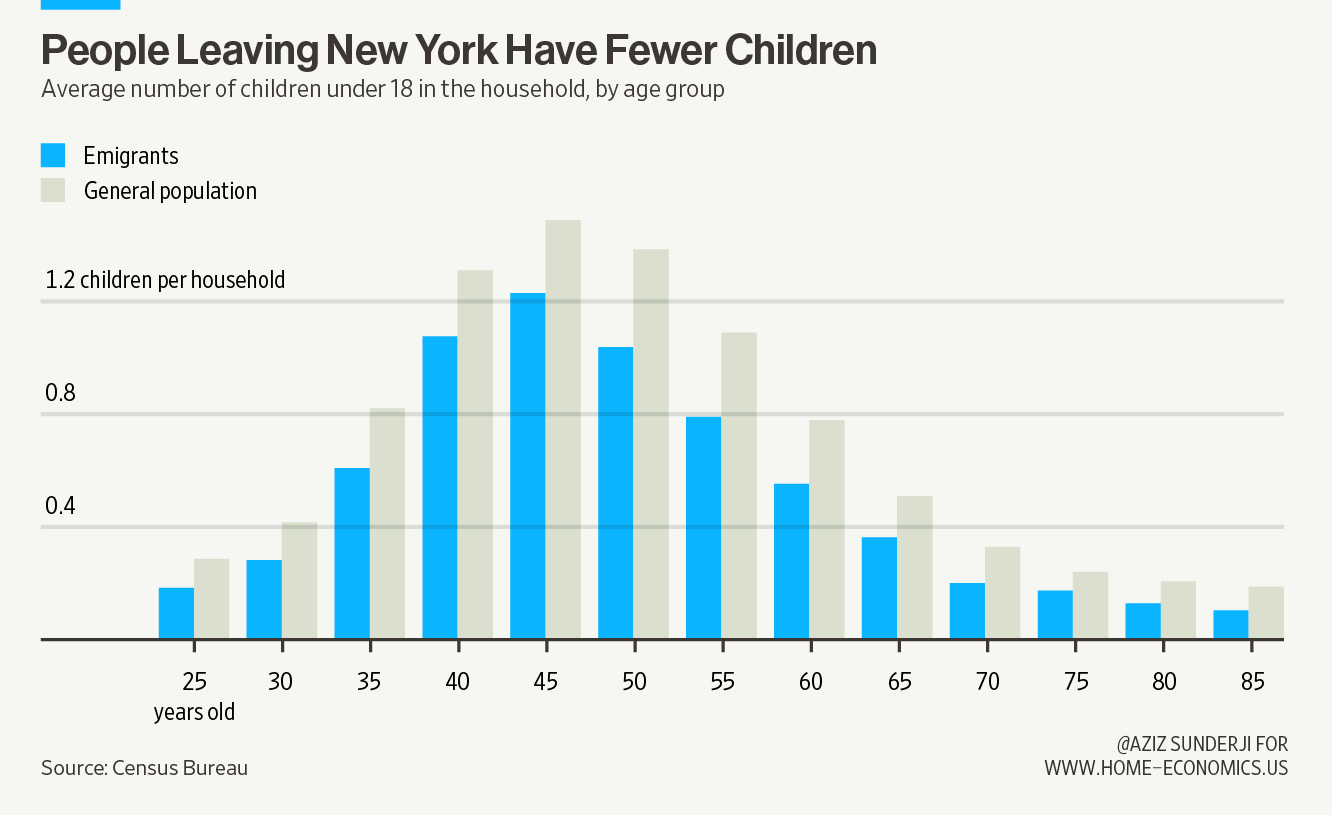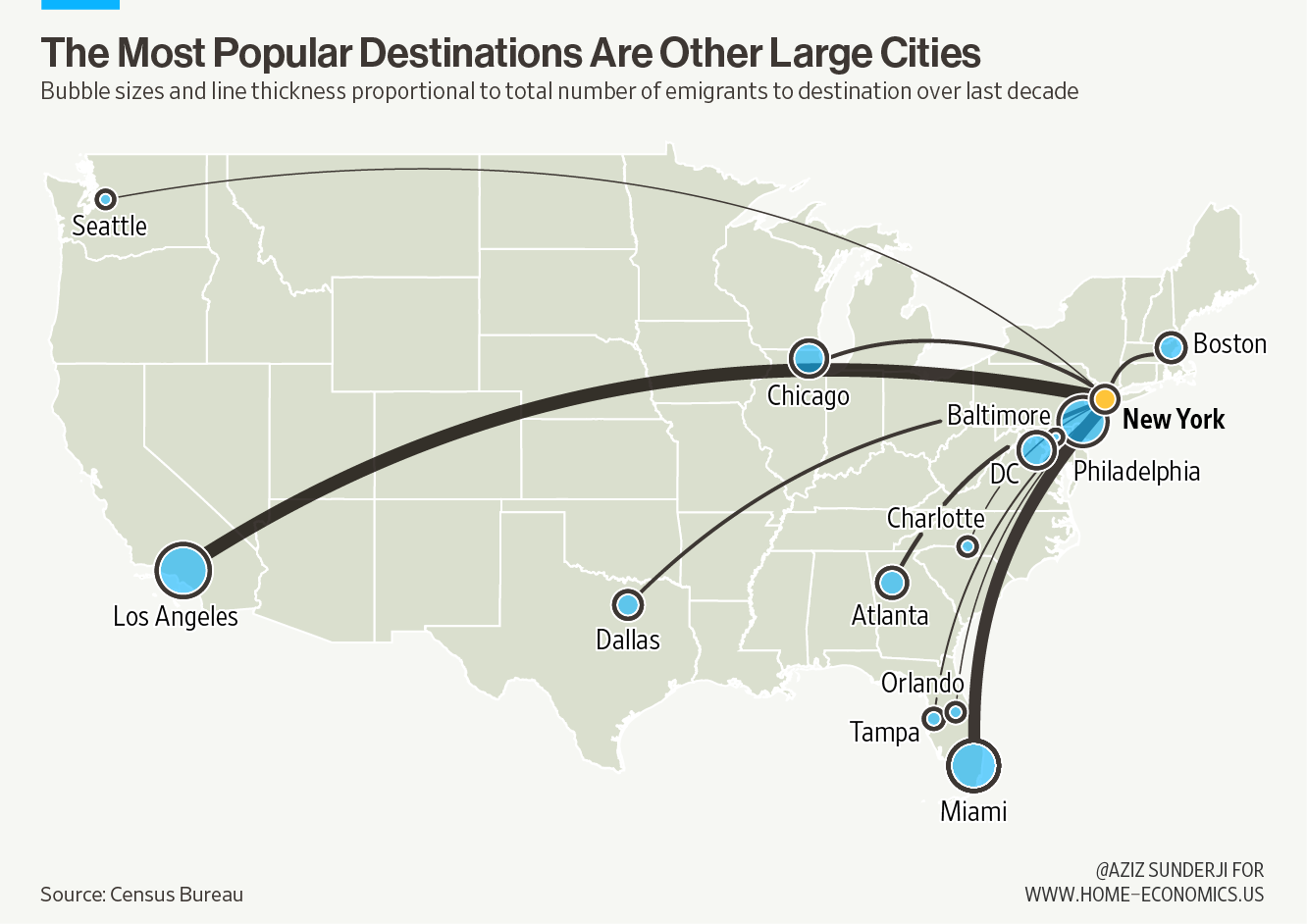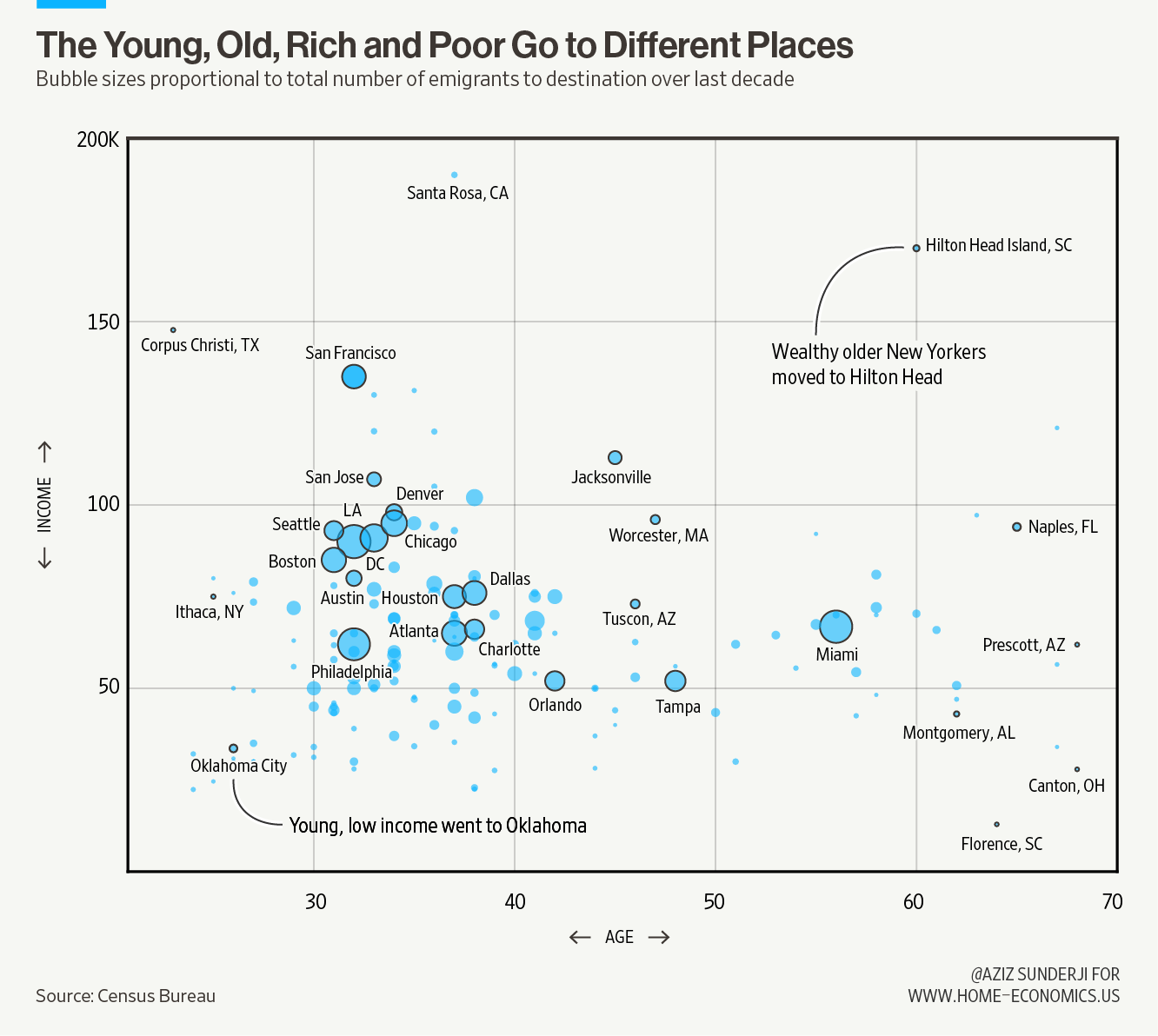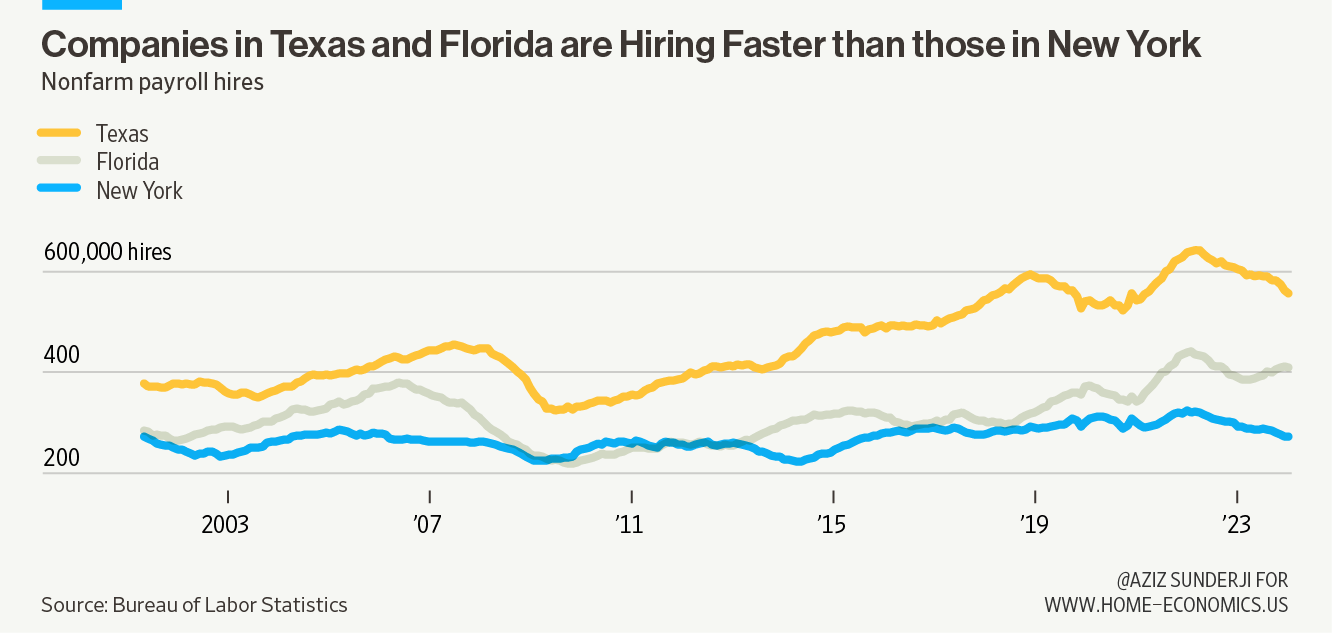Aziz Sunderji - Why is New York City Shrinking?
Welcome back to Home Economics, a data-driven newsletter about the American housing market. Today’s article is about New York City’s rapidly shrinking population—what’s going on? Subscribe here: New York in contextSummer quietude aside, New York feels like it’s booming these days. Securing a restaurant reservation is as challenging as ever. Lineups for tennis courts form at dawn. Rents are rising faster than just about anywhere else. You’d be forgiven for thinking this city is heaving with more sharp-elbowed, jostling bodies than ever before. You’d be wrong. New York is shrinking, and faster than ever. Over the past 3 years, the population has declined by almost 500,000. On a ranking of the country’s contracting cities, New York handily takes the top spot, shrinking by 400,000 more than the next on the list (Chicago). New York City is 6% smaller than in 2020, the most severe decline in the largest 50 US cities over this horizon, after San Francisco (-7%). To be fair, the pandemic has not been great for urban life in general: the top 10 cities outside New York have collectively failed to add any new residents since 2020. Still, most cities have merely stagnated. New York has experienced an exodus. It’s not just a pandemic thingThis is not a new phenomenon. New York has steadily added fewer and fewer people every year since 2012, and population growth turned negative in 2018—well before Covid. In the decade to 2023, the city shrank by 140,000 (the deep population losses over the past few years slightly overshadow the small gains from 2013-2016). That’s a small number considering the size of the city, amounting to a loss of only 2% of the population. It’s in line, in percentage terms, with some other large cities like Los Angeles and Chicago. But consider that, over the same horizon, Phoenix grew by 8%, Austin by 12%, and Forth Worth by 23%. It’s a domestic migration thingNothing changed abruptly in 2012. Long before then, New Yorkers were leaving the city in greater numbers than people were arriving from the rest of the country. But before 2012, the migration gap was small: often a net loss of around 50,000 people per year. And the city nevertheless still grew in size, because that release of population to the rest of the country was more than made up for by international arrivals and net births. What changed? Net births declined slightly, due to an aging population, falling fertility—and in the past few years—the pandemic. International migration cooled during the Trump years, and then came to a virtual standstill in 2020-21. At least some of these factors are likely to prove temporary. But by far the biggest change was an acceleration in the pace of people leaving the city for other places in the country. This is shown as falling ’net domestic migration’ in the chart below, on the right side. It’s the economy, stupidThe conventional narrative is that people are leaving the city because of some combination of the following factors: housing is unaffordable; taxes are too high; there is too much regulation; and there is too much crime. But affordability is the factor that most commentators emphasize. Yet, Census data suggests the primary motivation lies somewhere else. The chart below shows what people who left New York between 2012 and 2023 told the Census Bureau about their reason for moving. Jobs were, by far, the biggest reason New Yorkers cited for moving out of the state. Family was the second reason. Cheaper housing was the third. To be fair, the Census offers many possible responses to this question, and a number of the popular responses hint at affordability concerns, albeit indirectly, even if they don’t mention affordability specifically. For example, how many of the thousands of people who said they left the city because they “wanted to own [their own] home” are really saying, homes here are unaffordable? Still, even when we add up the number of people who cited any of the reasons that suggest the possibility that affordability is the ultimate driver, cheaper housing is a less important motivation of out-migration than jobs. Digging deeperIn order to get a more holistic view of emigration from New York, we need more information: who are the movers—what are their demographic characteristics like age, income, and number of children? Where are they going? In order to answer these questions I analyzed Census Bureau microdata (the millions of Census Bureau records about individual households). In the rest of this article, I draw on my analysis of 10 years of this microdata to establish who moved away from the city. I infer the motives of the migrants based on their demographic characteristics and where they moved. The evidence I’ve collected here suggests affordability has played a role in the city’s depopulation, but a less important one than young people seeking jobs elsewhere, and older people seeking sunshine. Kids these daysAt least in one way, the conventional narrative is correct: the people leaving New York skew young. The chart below shows the distribution of New Yorkers who left the city in any given year from 2012-23, versus the overall New York City population. While the age of New Yorkers is normally distributed around 50 years old, the emigrants are disproportionately concentrated amongst 25-40 year olds. This finding could corroborate the notion that jobs are the primary motivation for leaving the city, since younger people’s careers are more in flux, and could require a geographic shift. But it might equally substantiate the affordability narrative, since younger people have lower incomes and face the brunt of high home prices. Let’s look at incomes. The young (rich) and the restlessYoung emigrants earn substantially more than the overall New York population. But above the age of 45, the people leaving the city tend to have lower incomes than the overall city population at the same age. To me, this suggests that jobs might be the primary motive for younger people to leave the city, while affordability may be (surprisingly, to me at least) a bigger issue for older people. Are cities for childless cat ladies?One of my favorite movies, American Beauty, is about a young urban guy who falls in love, gets married, has a baby girl, and wakes up on what feels like the next day as a suburban dad with a teenage daughter that is embarrassed by him, a wife that resents him, and a job he hates. Ah, the American dream! Still, it does feel like the city-to-suburbs journey is pretty standard for most who choose to have kids, hopefully without the family issues and dead-end job. In the conventional view (and my prior, too), people leaving New York are responding primarily to the financial and lifestyle pressures of having kids. But this appears to be untrue: at every age, people who leave the city have fewer kids than the overall population. The chart above captures people who lived in New York and moved homes in the year prior to completing a Census survey, whether they moved from downtown Manhattan to Brooklyn or to Miami. Maybe those who moved from New York City to the suburbs (rather than another city), like the dad in American Beauty, have more kids? I isolated intra-metro movers and yes, they do have more kids—but only slightly more, and still far less than those who didn’t move at all. Where are they going?The vast majority of New Yorkers who move from one home to another are doing so within the NY metro area. To put this in context: Los Angeles is the most popular destination for New Yorkers who leave New York. But for every one New Yorker who moves to LA, 12 of them move within the NY metro area. These intra-metro area moves are interesting, but outside the scope of my analysis here. Amongst New Yorkers who moved away from the local metro area, the five most popular destinations were:
At this risk of beating a dead horse: aside from Philadelphia, these are not the kinds of destinations that make a lot of sense if one is fleeing high housing costs. Prices in LA are not much lower than they are in New York, especially if you factor in home insurance and that other LA necessity—a car. Call me JDI’ve likely, by this point, alienated a chunk of readers, not least those who have left New York, or other high-cost cities, because of housing affordability issues, as well as those who may not be struggling themselves but are sympathetic to those that are. But, to be clear: I am not arguing that affordability is not a challenge for many Americans, and especially those who live in high-cost cities. I count myself among them! It’s merely that housing refugees do not seem to comprise the majority of those who move. But affordability is a problem for many, and the analysis below might help tease out who those people are. Below, I break out the destinations for emigrating New Yorkers over the past decade by age and income. Old, rich people have moved to places like Hilton Head, and Naples, Florida. But there are lots of lower income seniors who moved to places like Montgomery (AL), Canton (OH), or Florence (SC). Miami is the most popular destination for older people, and those who moved there were, on average, in the middle of the income distribution. Wealthier middle-aged people gravitate to places like Jacksonville, FL and Worcester, MA. In the middle of the income spectrum, people at this age like Tucson, AZ. Lower income middle-aged people prefer Tampa. There are lots of data points when we look below 40 (remember, most movers are young). I find these results pretty intuitive: the kinds of people who move to San Francisco are young and have high incomes (~$140K). Other popular destinations for relatively high-earning young people are San Jose, Denver, Chicago, LA, Seattle, DC, and Boston. Note that these are all pretty expensive, jobs-laden cities. It’s likely jobs, not affordability, motivating these emigrants. Places like Dallas, Houston, Atlanta, and Charlotte attract young, lower income New Yorkers. This feels like the set of households that the conventional narrative about young people facing affordability challenges and moving to the South most clearly exemplify. I would have expected to see more young, lower income people moving to upstate New York—but that does not seem to be a major destination, though Ithaca, Syracuse, and Albany NY appear to be moderately popular destinations. Blue states can’t govern?Another purported reason people are leaving New York: blue states and cities are poorly governed; they’re mired in red tape and regulation that prevents them from building more housing and bringing down prices. For example, writing in the NYT, David Brooks argues:
Those red states are indeed growing faster, but emigrating New Yorkers do not appear to favor Republican-governed cities more than others. They’re moving to blue cities in blue states, like Los Angeles, and to blue cities in red states, like Atlanta, as much as they are to red cities in red states (Dallas, Houston, and Charlotte, for example). For what it’s worth, it tends to be a slice of the overall population—and lower income New Yorkers in particular—who are moving to the kinds of places Brooks cites. ConclusionsNew York City is shrinking because the pace of domestic out-migration has accelerated. Most people who leave the city are younger, higher income, and have fewer kids, compared to the overall New York City population. Jobs seems to be the most important driver of emigration, more than housing affordability. Higher-earning young New Yorkers are moving to places like Los Angeles, San Francisco, and Washington, DC—hardly bastions of cheap homes. Moreover, Census Bureau surveys that directly ask about the reason for moving show that, for emigrating New Yorkers, jobs are more important than any other consideration. There is evidence that some of these emigrants are motivated by concerns about stretched home affordability: some younger, lower income New Yorkers are moving to cheaper cities, particularly in Texas. This is not incompatible with jobs also being a key concern: payrolls data shows (below) that companies in Florida and Texas have been hiring more people than those in New York, especially over the last decade. Home Economics is a reader-supported publication. Please consider upgrading to a paid subscription to support our work. Paying clients receive access to the full archive, forecasts, data sets, and exclusive in-depth analysis. This edition is free—you can forward it to colleagues who appreciate concise, data-driven housing analysis. |
Older messages
The Week in Review
Sunday, August 4, 2024
Week of July 29th — Recession Risks Rise ͏ ͏ ͏ ͏ ͏ ͏ ͏ ͏ ͏ ͏ ͏ ͏ ͏ ͏ ͏ ͏ ͏ ͏ ͏ ͏ ͏ ͏ ͏ ͏ ͏ ͏ ͏ ͏ ͏ ͏ ͏ ͏ ͏ ͏ ͏ ͏ ͏ ͏ ͏ ͏ ͏ ͏ ͏ ͏ ͏ ͏ ͏ ͏ ͏ ͏ ͏ ͏ ͏ ͏ ͏ ͏ ͏ ͏ ͏ ͏ ͏ ͏ ͏ ͏ ͏ ͏ ͏ ͏ ͏ ͏ ͏ ͏ ͏ ͏ ͏ ͏ ͏ ͏ ͏ ͏
The Week in Review
Saturday, July 27, 2024
Week of July 22 – Home Sales Slump ͏ ͏ ͏ ͏ ͏ ͏ ͏ ͏ ͏ ͏ ͏ ͏ ͏ ͏ ͏ ͏ ͏ ͏ ͏ ͏ ͏ ͏ ͏ ͏ ͏ ͏ ͏ ͏ ͏ ͏ ͏ ͏ ͏ ͏ ͏ ͏ ͏ ͏ ͏ ͏ ͏ ͏ ͏ ͏ ͏ ͏ ͏ ͏ ͏ ͏ ͏ ͏ ͏ ͏ ͏ ͏ ͏ ͏ ͏ ͏ ͏ ͏ ͏ ͏ ͏ ͏ ͏ ͏ ͏ ͏ ͏ ͏ ͏ ͏ ͏ ͏ ͏ ͏ ͏ ͏ ͏ ͏ ͏
Runaway Rents in Big American Cities
Monday, July 22, 2024
Rents are rising quickly in some big cities ͏ ͏ ͏ ͏ ͏ ͏ ͏ ͏ ͏ ͏ ͏ ͏ ͏ ͏ ͏ ͏ ͏ ͏ ͏ ͏ ͏ ͏ ͏ ͏ ͏ ͏ ͏ ͏ ͏ ͏ ͏ ͏ ͏ ͏ ͏ ͏ ͏ ͏ ͏ ͏ ͏ ͏ ͏ ͏ ͏ ͏ ͏ ͏ ͏ ͏ ͏ ͏ ͏ ͏ ͏ ͏ ͏ ͏ ͏ ͏ ͏ ͏ ͏ ͏ ͏ ͏ ͏ ͏ ͏ ͏ ͏ ͏ ͏ ͏ ͏ ͏ ͏ ͏ ͏
Are YIMBYs Wrong about the Housing Crisis?
Wednesday, July 17, 2024
Cameron Murray is skeptical about upzoning's potential ͏ ͏ ͏ ͏ ͏ ͏ ͏ ͏ ͏ ͏ ͏ ͏ ͏ ͏ ͏ ͏ ͏ ͏ ͏ ͏ ͏ ͏ ͏ ͏ ͏ ͏ ͏ ͏ ͏ ͏ ͏ ͏ ͏ ͏ ͏ ͏ ͏ ͏ ͏ ͏ ͏ ͏ ͏ ͏ ͏ ͏ ͏ ͏ ͏ ͏ ͏ ͏ ͏ ͏ ͏ ͏ ͏ ͏ ͏ ͏ ͏ ͏ ͏ ͏ ͏ ͏ ͏ ͏ ͏ ͏ ͏
The Week in Review
Sunday, July 14, 2024
Week of July 8th — Home Prices Decelerate, Inflation Diminishes ͏ ͏ ͏ ͏ ͏ ͏ ͏ ͏ ͏ ͏ ͏ ͏ ͏ ͏ ͏ ͏ ͏ ͏ ͏ ͏ ͏ ͏ ͏ ͏ ͏ ͏ ͏ ͏ ͏ ͏ ͏ ͏ ͏ ͏ ͏ ͏ ͏ ͏ ͏ ͏ ͏ ͏ ͏ ͏ ͏ ͏ ͏ ͏ ͏ ͏ ͏ ͏ ͏ ͏ ͏ ͏ ͏ ͏ ͏ ͏ ͏ ͏ ͏ ͏ ͏ ͏ ͏ ͏ ͏
You Might Also Like
Weekend: Introducing the Butt Mullet Dress 👀
Sunday, March 9, 2025
— Check out what we Skimm'd for you today March 9, 2025 Subscribe Read in browser Header Image But first: Join the waitlist for a new premium Skimm experience Update location or View forecast
Starting Thursday: Rediscover Inspiration Through Wordsworth
Sunday, March 9, 2025
Last chance to register for our next literary seminar starting March 13. March Literary Seminar: Timothy Donnelly on William Wordsworth Rediscover one of the most influential poets of all time with
5 little treats for these strange and uncertain times
Sunday, March 9, 2025
Little treat culture? In this economy?
RI#266 - Down the rabbit hole/ What is "feels-like" temp/ Realtime voice tutor
Sunday, March 9, 2025
Hello again! My name is Alex and every week I share with you the 5 most useful links for self-improvement and productivity that I have found on the web. ---------------------------------------- You are
Chaos Theory: How Trump is Destroying the Economy
Sunday, March 9, 2025
Trump's erratic, chaotic governing style is dragging down the economy ͏ ͏ ͏ ͏ ͏ ͏ ͏ ͏ ͏ ͏ ͏ ͏ ͏ ͏ ͏ ͏ ͏ ͏ ͏ ͏ ͏ ͏ ͏ ͏ ͏ ͏ ͏ ͏ ͏ ͏ ͏ ͏ ͏ ͏ ͏ ͏ ͏ ͏ ͏ ͏ ͏ ͏ ͏ ͏ ͏ ͏ ͏ ͏ ͏ ͏ ͏ ͏ ͏ ͏ ͏ ͏ ͏ ͏ ͏ ͏ ͏ ͏ ͏ ͏
Chicken Shed Chronicles.
Sunday, March 9, 2025
Inspiration For You. ͏ ͏ ͏ ͏ ͏ ͏ ͏ ͏ ͏ ͏ ͏ ͏ ͏ ͏ ͏ ͏ ͏ ͏ ͏ ͏ ͏ ͏ ͏ ͏ ͏ ͏ ͏ ͏ ͏ ͏ ͏ ͏ ͏ ͏ ͏ ͏ ͏ ͏ ͏ ͏ ͏ ͏ ͏ ͏ ͏ ͏ ͏ ͏ ͏ ͏ ͏ ͏ ͏ ͏ ͏ ͏ ͏ ͏ ͏ ͏ ͏ ͏ ͏ ͏ ͏ ͏ ͏ ͏ ͏ ͏ ͏ ͏ ͏ ͏ ͏ ͏ ͏ ͏ ͏ ͏ ͏ ͏ ͏ ͏ ͏ ͏ ͏ ͏ ͏ ͏
“Hymn of Nature” by Felicia Dorothea Hemans
Sunday, March 9, 2025
O! Blest art thou whose steps may rove ͏ ͏ ͏ ͏ ͏ ͏ ͏ ͏ ͏ ͏ ͏ ͏ ͏ ͏ ͏ ͏ ͏ ͏ ͏ ͏ ͏ ͏ ͏ ͏ ͏ ͏ ͏ ͏ ͏ ͏ ͏ ͏ ͏ ͏ ͏ ͏ ͏ ͏ ͏ ͏ ͏
Claim Your Special Men's Health Offer Today!
Sunday, March 9, 2025
Subscribe to Men's Health today! Men's Health logo Get stronger, smarter, better 1 year of print mag + digital mag access Men's Health Magazine is the essential read for active, successful,
The 2025 Color Trends You *Should* Be Wearing Right Now
Sunday, March 9, 2025
They pack a playful punch. The Zoe Report Daily The Zoe Report 3.8.2025 The 2025 Color Trends You *Should* Be Wearing Right Now (Trends) The 2025 Color Trends You *Should* Be Wearing Right Now They
6 Most Common Tax Myths, Debunked
Saturday, March 8, 2025
How to Finally Stick With a Fitness Habit. Avoid costly mistakes in the days and weeks leading up to April 15. Not displaying correctly? View this newsletter online. TODAY'S FEATURED STORY Six of
